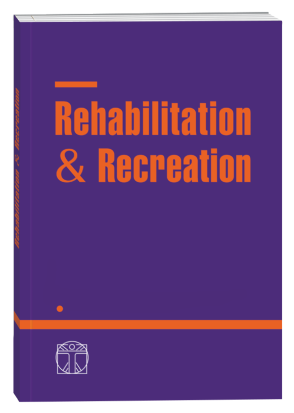USE OF INNOVATIVE TECHNOLOGIES AND COMPUTER PROGRAMS FOR THE RECOVERY OF COGNITIVE FUNCTIONS AFTER STROKE
DOI:
https://doi.org/10.32782/2522-1795.2024.18.1Keywords:
neurorehabilitation, stroke, movement disorders, innovative methods, virtual realityAbstract
The use of electromechanical and robotic devices in neurorehabilitation can significantly improve the quality of life and daily activities of patients who have suffered a stroke or suffer from other movement disorders. The purpose of this scientific work is to study and analyze the integration of innovative methods into rehabilitation programs for patients after a stroke, and the creation of new rehabilitation algorithms for the restoration of cognitive functions in the early stages of rehabilitation. Material. The clinical study was conducted in the period from 2022 to 2024 based on the Neurological Department of the Municipal Enterprise “Poltava Regional Clinical Hospital named after M.V. Sklifosovsky of Poltava Regional Council”. A total of 103 people took part in the study, of which 44 were women (42.72%) and 59 were men (57.28%). The age of the total group ranged from 45 to 64 years, with an average age of Criteria for assignment to subgroups 1.1–1.4: age from 45 to 74 years, both men and women with ischemic stroke, first (and only) stroke in history, with moderate cognitive impairment, mild dementia, without severe aphasia, epilepsy or epileptic syndromes in the anamnesis and available informed consent to participate in the study. Results. During stroke recovery, the use of a computer stimulation program can successfully improve cognitive function in 54.0% of patients. This is significantly different from the typical standard rehabilitation recovery (22.5%). Conclusions. The use of innovative methods in rehabilitation programs after a stroke helps to improve the results of the recovery of motor functions and increase the quality of life of patients. For the successful implementation of innovative methods, it is necessary to ensure appropriate training of personnel, create appropriate conditions, and carry out individualization of rehabilitation programs. Research on the longterm effects of innovative methods and their impact on the quality of life of patients is necessary to provide an objective assessment of their effectiveness.
References
Aam, S., Einstad, M.S., Munthe-Kaas, R., Lydersen, S., Ihle-Hansen, H., Knapskog, A.B., ... & Saltvedt, I. (2020). Post-stroke cognitive impairment – impact of follow-up time and stroke subtype on severity and cognitive profile: the Nor-COAST study. Frontiers in Neurology, 11:699. DOI: 10.3389/fneur.2020.00699.
Ambrosini, E., Gasperini, G., Zajc, J., Immick, N., Augsten, A., Rossini, M., ... & Krakow, K. (2021). A robotic system with emg-triggered functional electrical stimulation for restoring arm functions in stroke survivors. Neurorehabilitation and Neural Repair, 35(4):334–345. DOI: 10.1177/1545968321997769.
Anaya, M.A., & Branscheidt, M. (2019). Neurorehabilitation after stroke: from bedside to the laboratory and back. Stroke, 50(7):e180–e182. DOI: 10.1161/STROKEAHA.118.023878.
Baniqued, P.D.E., Stanyer, E.C., Awais, M., Alazmani, A., Jackson, A.E., Mon-Williams, M.A., ... & Holt, R.J. (2021). Brain-computer interface robotics for hand rehabilitation after stroke: A systematic review. Journal of Neuroengineering and Rehabilitation, 18(1):1–25.
Doumas, I., Everard, G., Dehem, S., & Lejeune, T. (2021). Serious games for upper limb rehabilitation after stroke: a meta-analysis. Journal of neuroengineering and rehabilitation, 18:1–16.
Garzo, A., Arcas-Ruiz-Ruano, J., Dorronsoro, I., Gaminde, G., Jung, J.H., Téllez, J., & Keller, T. (2022). MERLIN: upper-limb rehabilitation robot system for home environment. In Converging Clinical and Engineering Research on Neurorehabilitation IV: Proceedings of the 5th International Conference on Neurorehabilitation (ICNR2020), October 13–16, 2020 (pp. 823–827). Springer International Publishing.
Haire, C.M., Vuong, V., Tremblay, L., Patterson, K.K., Chen, J.L., & Thaut, M.H. (2021). Effects of therapeutic instrumental music performance and motor imagery on chronic post-stroke cognition and affect: A randomized controlled trial. NeuroRehabilitation, 48(2):195–208. DOI: 10.3233/NRE-208014.
Lang, C.E., Lohse, K.R., & Birkenmeier, R.L. (2015). Dose and timing in neurorehabilitation: prescribing motor therapy after stroke. Current opinion in neurology, 28(6):549–555. DOI: 10.1097/WCO.0000000000000256.
Maier, M., Ballester, B.R., & Verschure, P.F. (2019). Principles of neurorehabilitation after stroke based on motor learning and brain plasticity mechanisms. Frontiers in systems neuroscience, 13:74. DOI: 10.3389/ fnsys.2019.00074.
Park, J.H., Shin, J.H., Lee, H., Roh, J., & Park, H.S. (2021). Alterations in intermuscular coordination underlying isokinetic exercise after a stroke and their implications on neurorehabilitation. Journal of NeuroEngineering and Rehabilitation, 18:1–17.
Rasheed, N.M., & Tashtoush, M.A. (2023). The Impact of Cognitive Training Program for Children (CTPC) to Development the Mathematical Conceptual and Achievement. Journal of Higher Education Theory & Practice, 23(10). DOI: 10.33423/jhetp.v23i10.6196.
van de Rakt, J., & Mccarthy-Grunwald, S. (2021). Rehabilitation of the upper limb after a stroke. Part 1. The flexion attitude synergy an multi-eclectic approach. Italian Journal of Sports Rehabilitation and Posturology, 8(17):1829–1867.
Xu, J., Branscheidt, M., Schambra, H., Steiner, L., Widmer, M., Diedrichsen, J., ... & Cortes, J.C. (2019). Rethinking interhemispheric imbalance as a target for stroke neurorehabilitation. Annals of Neurology, 85(4):502–513. DOI: 10.1002/ana.25452.
Downloads
Published
How to Cite
Issue
Section
License

This work is licensed under a Creative Commons Attribution-NonCommercial-NoDerivatives 4.0 International License.












